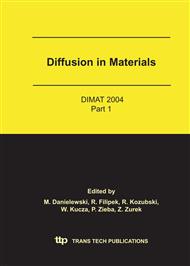p.543
p.548
p.554
p.560
p.566
p.572
p.578
p.584
p.593
Migration of Ion Implanted Hydrogen in Amorphous and Polycrystalline Si3N4:H Films: Experiments and Numerical Simulations
Abstract:
The tracer diffusion of ion implanted deuterium is studied in amorphous and polycrystalline magnetron-sputtered Si3N4:H films with secondary ion mass spectrometry (SIMS). The experimentally obtained diffusion profiles are numerically simulated by computer calculations based on the concept of trap-limited diffusion where the tracer atoms form immobile complexes with: (a) intrinsic film defects like dangling bonds and (b) extrinsic defects caused by the implantation damage. For amorphous Si3N4:H films a moderately high dissociation rate of intrinsic complexes (dangling bonds) is present and time independent effective diffusivities are observed, which obey an Arrhenius law with an activation energy of DE = 3.4 eV and a pre-exponential factor of D0 = 4 x 10-4 m2/s. For polycrystalline Si3N4 films non-Gaussian depth profiles and strongly time dependent diffusivities are observed, which have their reason in the presence of intrinsic traps with negligible dissociation, presumably located at the grain boundaries.
Info:
Periodical:
Pages:
566-571
Citation:
Online since:
April 2005
Authors:
Price:
Сopyright:
© 2005 Trans Tech Publications Ltd. All Rights Reserved
Share:
Citation:


